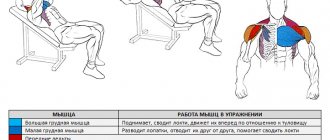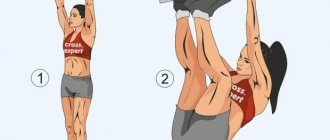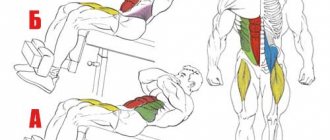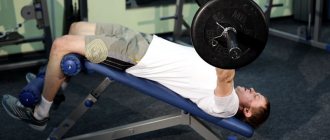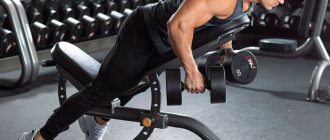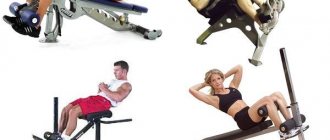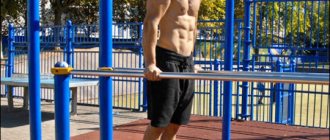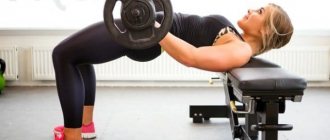The incline bench press exercise pumps up the upper chest. Expands and lifts the top of the pectoral muscles. Formative exercise.
The incline press is the most useful exercise for developing all the muscles of the shoulder girdle. It puts more stress on the upper pecs, “the hardest to pump,” and deltoids, as opposed to the standard bench press.
Thanks to the positive angle of the bench, the entire load is focused on the upper chest, highlighting and expanding this area.
When you do an incline bench press, the muscles in your torso and arms work in much the same way as when throwing a javelin, throwing a ball from your chest with both hands in basketball, throwing a straight punch in boxing, or pushing an opponent with both hands in rugby.
Bench press on an incline bench - an exercise for the pectoral muscles
Incline bench press. Technique
As I said, you can achieve maximum concentration of the load on the chest muscles in the following ways:
- Body position.
- Technique.
I think it’s clear about body position. You need to slightly raise the angle of the bench to 20-30 degrees so that the load falls mainly on the chest. We exclude the triceps and anterior delta from the work, thereby.
Hand position:
- The WIDER your hands hold the bar (if you press a barbell) = The stronger the stretch and the more the pecs are involved, BUT the smaller the amplitude of movement.
- The more your hands ALREADY hold the bar = The weaker the stretch, the more the triceps are activated, the greater the range of motion.
Solution: I suggest placing your hands IN MEDIUM (not too wide and not too close, approximately at the edges of the marks on the fretboard). So, to increase the range of motion, maintain stretching and reduce the work of the triceps.
Movement speed:
- We lift the projectile quickly = glycolytic fast muscle fibers (FMV) and high-threshold fast muscle fibers (HTF) work, if the weight is critically large (we can lift it 1-2 times).
- We lift the projectile slowly = oxidative slow muscle fibers (SMF) are activated.
Solution: For beginners, I advise lowering the projectile a little more slowly, concentrating on the sensations, and raising the projectile relatively quickly (without violating the technique). Don't focus on speed, focus on how you feel.
Leg position:
- The LOWER the legs = The greater the likelihood of a bridge, which will reduce the work of the chest (remember about electromyography?).
- The higher the legs = The easier it is to remove the bridge and focus on working the chest.
Solution: I advise you to throw your legs, say, on a row of dumbbells in front of you (I often do this if I press dumbbells), or on a bench. This way we will remove the arch in the back (bridge) and focus on working the chest.
Where to lower the bar:
As you already understand, if we lower the bar to the neck (in the “guillotine” style), then we load the pectoral muscles more (all parts of the chest work). Therefore, I see no point in lowering it to the nipples if your goal is large, beautiful breasts.
Solution: We lower the bar closer to the neck (if we press on a horizontal bench), and between the neck and nipples if we press on an inclined bench.
Breath:
Everything is simple here. Lower the projectile = INHALE. Raise the projectile = EXHALE!
Try not to hold your breath. This increases intraocular and blood pressure.
Well, don’t forget, friends, FOCUS ON YOUR FEELINGS!!! This comes first. Your body will tell you what is best.
Let's talk about my MOST FAVORITE exercise for developing chest muscles.
Recommendations
- This press is included in training programs to work the chest muscles, and not to set strength records in the press. Think of exercise as a means to pump up your muscles, not to satisfy your ego. Use medium weights and don't skip warm-up sets;
- Your forearms should be perpendicular to the floor during the press. This will set all other angles to be adequate;
- The bench is installed under the bar in such a way that the athlete does not overload the ligaments, that is, the press occurs in the plane of the middle of the chest, and not on the neck.
Incline Dumbbell Bench Press
The incline dumbbell press is truly my favorite exercise for developing the pectoral muscles.
Why?
Firstly, this is the best exercise in terms of involving the pectoral muscles in the work according to the results of Bret's experiments with electromyography.
Secondly, here are some other reasons:
- Because We don’t have a partition (bar) between the exercises, then we can lower the dumbbells lower, which means increasing the range of movement, thereby making our work more difficult.
- We can rotate (supinate) the dumbbells at the points of peak contraction in order to better feel the muscles. This is an important point, because allows the load to hit the target exactly.
- If we don’t have enough strength to complete one more repetition, then we don’t have to be afraid that the projectile will crush us. We can simply throw them on our sides, thereby not harming ourselves.
There are some inconveniences when using dumbbells:
- There comes a time when it becomes inconvenient to progress the load. For example, you already confidently press 40 kg dumbbells 12 times (and this is already quite a lot of weight), and you want to raise the working weight. Most likely, you will not find 41.25 kg or 42.5 kg dumbbells in the gym, but only 45 kg shells. And an increase in working weight of 5 kg per side (total weight 10 kg) is, as a rule, too much, unless, of course, you use pharmacology.
- The technique must be more carefully honed, otherwise the risk of injury is high. One awkward movement with a heavy enough dumbbell and you can get very unpleasant injuries (elbows or shoulders, ligaments and tendons). These injuries may prevent you from training normally in the future.
How to perform an incline dumbbell press? It's very simple, friends.
You CANNOT just take dumbbells and throw them upward with a swing. I've seen this many times. This easily leads to ruptured ligaments and tendons in the area of the shoulder and elbow joints.
- We do the dumbbell throw like this. Take two dumbbells, place them on your upper thighs (above your knees), and sit on a bench. Next, as it were, we throw one dumbbell with our knee, while simultaneously lying down on the bench, by inertia, working with the second knee, throwing the second dumbbell. Hold the dumbbells tightly and press them up. This is the STARTING POSITION.
- Relatively slowly lower the dumbbells down to the point of MAXIMUM STRETCH, feel how our chest stretches (we lower it to the area between the nipples and neck).
- Focusing on the sensations of your chest, press the dumbbells up at a slightly faster speed, KEEPING TENSION IN YOUR CHESTS throughout the entire lift.
- At the top point, we slightly supinate (turn) the hands with the dumbbells inward, additionally performing a PEAK CHEST CONTRACTION (we just additionally strain the pecs).
- It was one repeat.
I love starting my chest workout with this exercise. The chest becomes engorged, burns, and swells. Great feeling!
Information in the crossover through the upper blocks
This lower pectoral exercise is used to highlight the lower part of the pectoralis major muscle and clearly separate the chest muscles down the center of the torso. Recommended for advanced and more experienced athletes at the end of chest training after presses and flyes.
Exercise technique
1. Attach the appropriate handles to the upper cable carabiners. Stand firmly in the center of the crossover and take a step forward to give your body a stable position. 2. Keep your back straight and slightly lean your body forward. 3. Bend your elbows slightly. Until the end of the approach, this position of the elbows should remain unchanged. The movement is performed exclusively in the shoulder joint. 4. Take a deep breath and, holding your breath, bring the handles in front of you until they touch each other or a little further, crossing your arms. 5. At the moment of bringing the handles together, pause and hold the peak contraction in the muscles for at least a couple of seconds. Then slowly return your hands to the starting position.
Technique tips
- There is no point in using too heavy a weight in this exercise, since you will not be able to maintain a given angle in your elbows and will either bend your arms too much or straighten them completely.
- Again, do not try to help yourself with your whole body by taking significant weight. This will only take the load off your chest and reduce the effectiveness of the exercise.
- Bring your arms together in a wide arc, as if in a circle. By bending your elbows, you will be performing more of a pressing motion than a tuck.
- By bringing your arms too high, you shift the emphasis of the load to the upper chest and shoulders. By bringing your arms too low, the load shifts to the lower chest.
- By holding your breath and keeping your core muscles tense at all times, you increase your body's stability during the exercise.
Incline Barbell Press
Now I'm talking about the POSITIVE incline of the bench (when it is tilted up). A slightly less effective exercise, as we found out, but also has its advantages.
- First of all: A CONVENIENT OPPORTUNITY TO PROGRESS LOADS! We can increase the weights a little at a time, because... In almost any hall you can find pancakes of 0.5-1.25 kg.
- Further, the presence of a PARTITION between the implements (bar), which provides additional stabilization and the ability to press with an OPEN GRIP (when your thumb does not wrap around the bar, but is placed on the bar from below.
Here's a demonstration of the closed and open grip:
The technique is the SAME as for the incline dumbbell press.
- There is no need to throw anything away. Just lie down under the barbell, the bench is inclined, as we found out, by 20-30 degrees. Place your hands slightly wider than the marks (you will see them), this is a medium grip.
- Remove the bar from the racks. This is the starting position.
- Relatively slowly we lower the bar down to the point of MAXIMUM STRETCH, we feel how our chest is stretched (we lower it to the area between the nipples and neck).
- Focusing on the sensations in your chest, press the barbell up at a slightly faster speed, KEEPING TENSION IN YOUR CHESTS throughout the entire lift.
- At the top point, we additionally do a PEAK CHEST CONTRACTION (we just additionally strain our pecs).
- It was one repeat.
How to stay safe while bench pressing
A heavy barbell falling on the face, chest or abdomen can cause serious injury, broken ribs, internal bleeding and death. Therefore, when reaching 95-100% of your one-rep max, think about safety. Use one of two options:
- Ask for insurance. If you go to the gym without a friend, ask the instructor or one of the regulars. Just make sure the person has done this before and is not counting crows while you do the exercise.
- Do bench presses in a power rack. Place a bench press underneath it and place the safety supports just above your body line when you are in a horizontal position. When you press your chest up at the start, it will rise above the supports so you can perform the press through its full range. At the same time, the fall of the barbell will not break your ribs.
Incline press upside down
I have never done this exercise for chest development, because... it is practically useless to them. Plus, I would categorically not recommend it to people with blood pressure (and negative angles in general).
But for the development of triceps, this option is definitely great! With what?
The fact that tilting the bench upside down practically turns off the chest from the work, but very well includes the triceps. A large muscle group does not steal the load from a small one, which means the muscle will receive a load sufficient for growth.
I do the Smith press on an incline bench (in the Smith machine; this is a frame with a bar that moves only along a certain trajectory).
This way I can fully focus on working the triceps without being distracted by the work of the stabilizer muscles (which are always involved when working with free weights).
- We lower the bench from the horizontal by 10-20 degrees. We put our legs on the bench.
- We grab the bar at shoulder level or slightly narrower.
- We lower the projectile under control to a level just above the nipples, keeping our ELBOWS PARALLEL TO THE BODY! Do not separate them (otherwise the chest may turn on).
- We feel a stretch in the triceps.
- Starting the movement by contracting the triceps, squeeze the bar upward. At the top point we additionally strain the triceps (peak contraction).
- This is one repetition.
In general, I have a very cool article about how to pump up your arms quickly. There I listed and explained all the coolest exercises for developing beautiful hands.
Contraindications
Since the exercise is performed with heavy weights, the risk of injury increases.
The main contraindications for performing bench presses at an angle include:
- Diseases or injuries of the joints - shoulders, elbows and hands
- Injuries and sprains of muscles and ligaments involved in movement
- Heart and vascular diseases and high blood pressure
The barbell press is a heavy strength exercise. For people with heart problems, it is better to use moderate weight, because when lifting the barbell upward, the pressure increases and the load on the heart increases. And the more weight, the stronger it is.
Incline press for girls
Does the female gender need it?
I think yes and no.
Will explain. The pectoral muscles in women are very small by themselves.
Female Breasts = Some muscle + Breast + Fat.
There’s nothing special to pump there, so I don’t see any point in doing a separate chest workout! At most, I would advise doing dumbbell presses on an incline bench, because... This is the most effective exercise for chest development. And most girls don’t need more.
Most likely, there will not be enough recovery abilities.
Or you can do the incline press upside down in Smith, as I described above.
Don’t forget that girls have very few muscles in the upper body compared to the lower part, so send to the forest those who are trying to train you according to the men’s program, and even according to a deep split (each muscle group separately).
Introduction
In this article, we will try to answer the most frequently asked questions regarding chest training in the broadest sense of the word. What exercises should you do to pump up your pectoral muscles? What are the most effective exercises for the pectoral muscles? What basic exercises for the pectoral muscles should you do? We will answer these and many other questions with our large list of the most important, effective and popular exercises with a full description of the technique and features of their implementation.
Features of effective chest training in bodybuilding
- In order to achieve good results in the bench press, you need to strengthen the auxiliary muscles - the shoulders, back and triceps.
- Follow the correct technique when pressing the barbell - shoulder blades retracted, chest forward, heels resting on the floor. Imagine that you are pushing off the barbell with your hands as you press it up. Start with small weights and gradually progress.
- To achieve success in training, you need to see your weak points and work on them.
- Regardless of how you train, rest and proper nutrition play a major role in the process of gaining muscle mass.
Materials used: Training The Chest: What You Need To Know by Scott Donald
If you liked the article, share with your friends!
.
Number of repetitions and approaches
The number of repetitions and sets depends on your training goals.
for muscle growth
To increase muscle mass, do 8-12 reps in 3 sets with working weight (plus warm-up with light weights).
to increase strength
If you are trying to increase strength, then you need to work in the range of 3-6 repetitions for 5 approaches.
But don't blindly follow the recommended number of repetitions if your personal experience suggests otherwise. Each person needs to observe how his body reacts to one or another type of training and change the program to suit himself.
